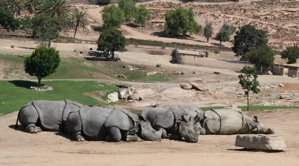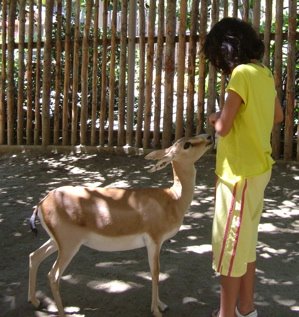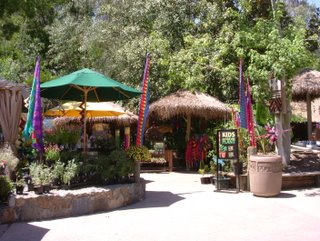The Wild animal park
For the last two days we have headed out of town to the picturesque San Pascuale Valley. You head north, turn left at Escondido (is that a fabulous name or what? Escondido.... Escondido ...you try it, go on, you know you want to...) and suddenly you are in farming country. Market gardens, ostrich farms, a ranch with lots of horses ... it's very pretty. The land still looks rather dry though and embedded in the small hills are big rounded boulders. Roadside vegetation includes what look like some sort of sunflower, maybe Jerusalem artichokes, and prickly pear cacti grow all over the hills (like gorse back home!).
All the way there, though, we wondered, what is the difference between a zoo and a wild animal park? Will this just be another zoo with bigger enclosures? Well, no. The San Diego Wild Animal Park is a wondrous place. The 'safari train' driver kept referring to it as 'Noah's Ark' and for some animals, it has been just that. Animals extinct in the wild that have been brought back to viable populations, and I'm sure the herd of 11 African elephants due to be culled in Swaziland were very pleased that the San Diego Wild Animal Park were able to airlift them out for a new life in the US. Incidentally, what's the difference between an African and an Asian elephant? African elephants are majestic, Asian elephants are pretty. What? Oh, oh yeah, there's something about the ears as well AND Asian elephants have one 'finger' on the end of their trunk, African elephants have two. And did you know, that as they grow older, elephants lose pigmentation on their skin, and actually do turn pink!! Here's Sunita, one of the Asian elephants - she's 57 and you can see the her pink skin around her upper trunk and ears.

Another big success story at the Wild Animal Park has been the Indian Rhino. These are the grey ones with the 'armour plating' not the white ones that you see in Auckland and Hamilton zoos. In 12 years they have raised 51 babies! Apparently, for these animals to breed, you need a large group of females. If there are not enough females, then they don't feel comfortable that they will be able to protect the young, and they just don't bother. Seems that the dear old lad just isn't up to the job of protection as well as procreation. At the Wild Animal Park they started with a herd of 22 females and just one male. Hoo boy! Here's a picture of one of the herds taking a nap.

The park is very large, with animals grouped together as appropriate. You'll probably need your magnifying glass to see the giraffes in this picture but it will give you an idea of the countryside and the enclosures. There's a 'safari train' tour that takes about 45 minutes - it's definitely worth doing, it's a big park!

Other fun things: I fed the lorikeets - it costs $2 and you get a little cup of 'nectar'. You hold it with your thumb and first finger, and the birds come and perch on your wrist to sip the goodies. It's really interesting to watch their dark tongues lapping up the liquid.

There's a 'petting kraal' for kids - you buy a handful of food pellets and boy those deer know who's got pellets! Here's Em being pestered by a very insistent dik dik...

The park is set out like African villages, with lots of colourful flags and spinners.

I hadn't heard of the Wild Animal Park before this trip, but my advice is, if you get the chance to come here, set aside a day to visit it. Come early before it gets too hot, and so that you can get a seat on the train without waiting very long. There's so much bad news about the environment, about animal extinctions and endangerments, that it's just wonderful to come across a place that is doing so much successful work with endangered species, some truly good news. The place is full of young animals, a testament to their work. If I lived here, I'd be there every week (until they gave me a job ...!!!)

0 Comments:
Post a Comment
<< Home